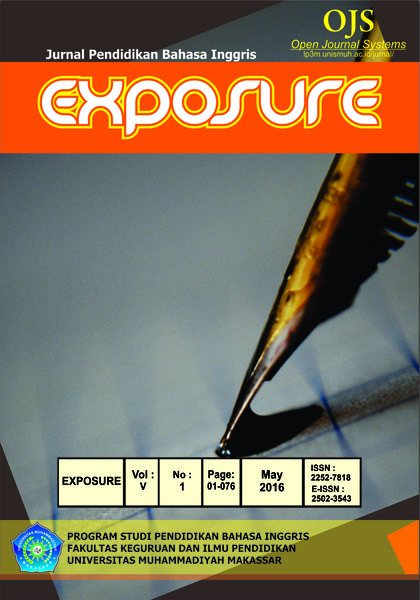TEACHER’S STRATEGY IN MAINTAINING THE FLOW OF STUDENTS’ ENGLISH INTERACTION IN SPEAKING CLASS
DOI:
https://doi.org/10.26618/exposure.v5i1.809Abstract
This qualitative mini-research aimed to reveal the strategy used by a teacher in speaking class. The researcher observed a teacher in one of the private university in Makassar for three meetings in a speaking class. In addition, the researcher did an interview with the teacher and her fifteen students who attended in her class. The finding implied that the teacher employed communicative approach by giving pair and group work activities. She also applied a rule Don’t Speak in Bahasa (no one is allowed to speak in Indonesia including herself) with reward and punishment. Moreover, the interview indicated that the teacher’s strategy in speaking class motivated the students to speak fully in English and built up their confidence.
Keywords: speaking, strategy, rule.
References
Abassi, Malik Abdul, 2011. A Survey of Teaching Strategies in ESL Classroom, (Online), (www.languageinindia.com. Retrieved on January 7, 2012)
Atmowardoyo, Haryanto. 2008. Metode Penelitian Kualitatif: Teori Dasar. Makassar: Badan Penerbit Universitas Negeri Makassar.
Brown, H.D. 2007. Teaching by Principles: An Interactive approach to language pedagogy (3rd Edition). Englewood Cliff, New Jersey: Prentice Hall Regent. White Plains, New York: Longman
Gay, L.R, et al. 2006. Educational Research: Competencies for Analysis and Application Eighth Edition. New Jersey: Person Education, Inc.
Harmers, John. 1998. The Practice of English Language Teaching. London: Longman
Harmer, Jeremy. 2008. The Practice of English Language Teaching (4th Edition). Britain: Person Education, Inc.
Ibadurrahman, Ihsan. 2011. Using Norms of Behavior to Regulate an English Only Speaking Class, (Online), (http://www.slideshare.net/, Retrieved on January 23 2012)
Pollard, Lucy. 2008. Guide to Teaching English: A Book to Help You through Your First Two Years in Teaching. Copyright © Lucy Pollard 2008 All Rights Reserved.
Richards, C. Jack. 1990. Conversationally speaking: approaches to the teaching of conversation. In Jack C Richards. The Language Teaching Matrix. New York: Cambridge University Press. 67-85
Richard, C. Jack. And Rodgers, S. Theodore. 1995. Approaches and Methods in Language Teaching. Cambridge University Press. USA
Savignon, S. J. 1983. Communicative competence: Theory and classroom practice. ing, MA: Addison-Wesley.
Spratt, Mary. Pulverness, Alan. And Williams, Melanie. 2005. The TKT
Course: Teaching Knowledge Test. Cambridge University Press. UK.
Thompson, G. (1996). Some Misconceptions about Communicative Language Teaching. English Language Teaching Journal. 50/1. 1996
Ur, Penny. (1996). a Course in Language Teaching: Practice & Theory. Cambridge University Press.
Downloads
Published
Issue
Section
License
Authors who publish with this journal agree to the following terms:
In order to assure the highest standards for published articles, a peer review policy is applied. In pursue of the compliance with academic standards, all parties involved in the publishing process (the authors, the editors and the editorial board and the reviewers) agree to meet the responsibilities stated below in accordance to the Journal publication ethics and malpractice statement.
Duties of Authors:
- The author(s) warrant that the submitted article is an original work, which has not been previously published, and that they have obtained an agreement from any co-author(s) prior to the manuscript’s submission;
- The author(s) should not submit articles describing essentially the same research to more than one journal;
- The authors(s) make certain that the manuscript meets the terms of the Manuscript Submission Guideline regarding appropriate academic citation and that no copyright infringement occurs;
- The authors(s) should inform the editors about any conflict of interests and report any errors they subsequently, discover in their manuscript.
Duties of Editors and the Editorial Board:
- The editors, together with the editorial board, are responsible for deciding upon the publication or rejection of the submitted manuscripts based only on their originality, significance, and relevance to the domains of the journal;
- The editors evaluate the manuscripts compliance with academic criteria, the domains of the journal and the guidelines;
- The editors must at all times respect the confidentiality of any information pertaining to the submitted manuscripts;
- The editors assign the review of each manuscript to two reviewers chosen according to their domains of expertise. The editors must take into account any conflict of interest reported by the authors and the reviewers.
- The editors must ensure that the comments and recommendations of the reviewers are sent to the author(s) in due time and that the manuscripts are returned to the editors, who take the final decision to publish them or not.
Authors are permitted and encouraged to post online a pre-publication manuscript (but not the Publisher’s final formatted PDF version of the Work) in institutional repositories or on their Websites prior to and during the submission process, as it can lead to productive exchanges, as well as earlier and greater citation of published work (see The Effect of Open Access). Any such posting made before acceptance and publication of the Work shall be updated upon publication to include a reference to the Publisher-assigned DOI (Digital Object Identifier) and a link to the online abstract for the final published Work in the Journal.

